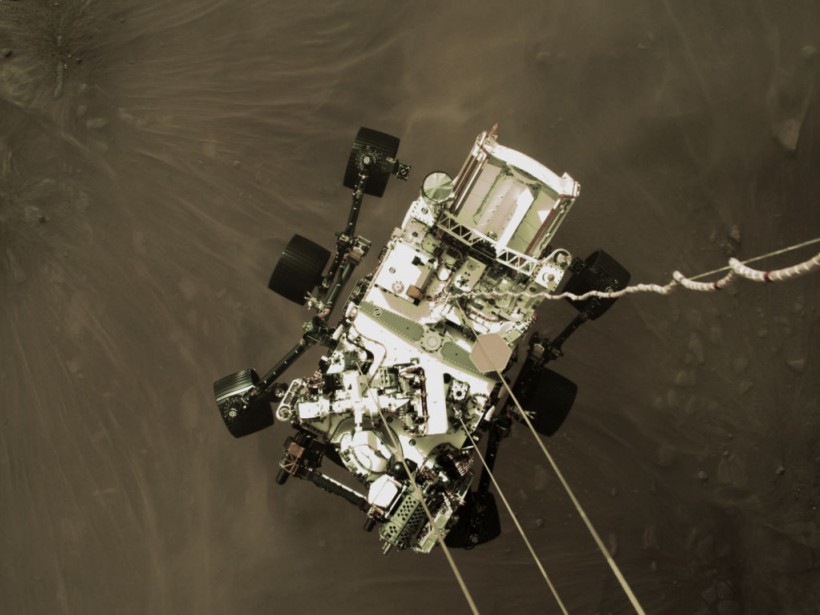After more than a year on Mars, NASA's Perseverance rover stumbled upon evidence of Earthlings. However, these are not clues from the red planet that many of us expect, as the object found was simply the rover's parachute and backshell, which were used upon its landing on February 18, 2021.
The Mars 2020 landing marks a successful milestone for modern astronomical studies. The mission's focus is for the Perseverance rover to bring back samples from the red planet. Experts believe that the martian rocks hold substantial evidence of the previous life and even the planet's birth.
Crash Artifacts from Perseverance Rover Landing

JEZERO CRATER, MARS - FEBRUARY 18: In this handout image provided by NASA, a still image is part of a video taken by several cameras aboard the descent stage as NASA’s Perseverance rover as it touched down in the area known as Jezero crater on February 18, 2021, on the planet Mars. A key objective for Perseverance's mission on Mars is astrobiology, including the search for signs of ancient microbial life. The rover will characterize the planet's geology and past climate, paving the way for human exploration of the Red Planet and be the first mission to collect and cache Martian rock and regolith.
Perseverance rover stumbled upon its previous landing equipment 13 months after its touchdown on Mars. The objects were captured by the rover's high-quality MastCam-Z imaging instrument. According to a report by Science Alert, the materials were spotted by the rover on Sol 404 on Mars or on April 6 on Earth.
Perseverance saw its landing parachute and backshell while traveling across a martian region called the Jezero Crater. In this place, the rover must examine an area called South Seitah for the mission's objectives to proceed. The crater is full of uneven terrain, which makes it challenging for Perseverance to roam around the place quickly.
The Perseverance rover first landed near the South Seitah. From there, the parachute was used for the Skycrane to place the vehicle in its best position on the surface.
I’ve been “pedal to the metal” lately, focused on my drive to the upcoming delta. But I’ve also spotted a few interesting things along the way: look closely and you’ll see part of the parachute and capsule I rode in on. Definitely wouldn’t be where I am without them! pic.twitter.com/JyJLXQCQvS
— NASA's Perseverance Mars Rover (@NASAPersevere) April 14, 2022
Many can remember that the parachute used by Perseverance had a secret message embedded in it. The texts were inserted in between the folds and the colors of the equipment. A traverse map of the rover was released by the Perseverance team, showing the vehicle's travel history across the martian soil. The HiRISE camera plotted the map from the Mars Reconnaissance Orbiter. The image shows each spot where the parachute, backshell, and other landing materials were left.
ALSO READ: Lyrids Meteor Shower 2022: How to Watch Hundreds of Fireballs Across The Sky This Week
Where is Perseverance Today
The HiRISE map has been updated since the landing of Perseverance, showing the exact location of the Mars rover. Other parts of the descent system were captured by the camera. Some of the insets are at least 200 meters across. The Perseverance rover can be seen in the blast pattern of the Skycrane vehicle, the same spot it descended from space. After the rover's landing, the Skycrane flew off the area and changed its trajectory to conduct a safety crash. This caused a V-shaped pattern on a surface nearby the landing site.
Sol 404: Parachute Found.@NASAPersevere Sol 404 pic.twitter.com/sExaxitYHu
— Kevin M. Gill (@kevinmgill) April 10, 2022
Perseverance's next objective is to examine the region that scientists theorized was once a river delta. The South Seitah exploration serves as the initial progress that will lead the rover to the place of interest.
In the latest records, the Perseverance rover broke the record of its predecessors' distance travel in a single day. The rover achieved a 319.8-meter drive across Mars on Sol 351. According to Universe Today, Curiosity did not exceed a 200-meter drive, while the Opportunity obtained a record of only a 228-meter drive.
RELATED ARTICLE: Pentagon Releases Over 1,500 Pages of Declassified Encounters with Our Space Neighbors
Check out more news and information on Space in Science Times.














